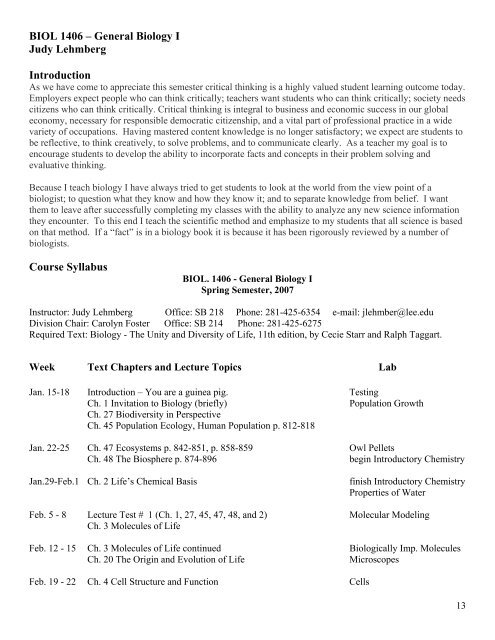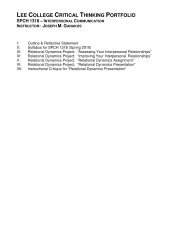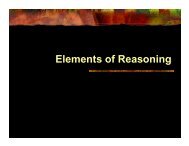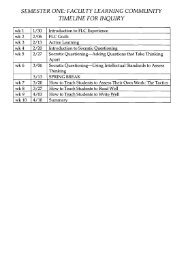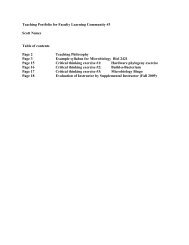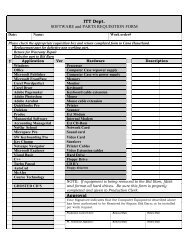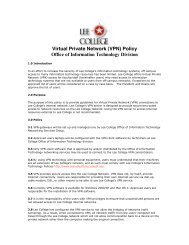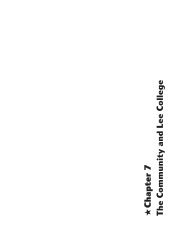Judy Lehmberg (FLC I) - Lee College
Judy Lehmberg (FLC I) - Lee College
Judy Lehmberg (FLC I) - Lee College
You also want an ePaper? Increase the reach of your titles
YUMPU automatically turns print PDFs into web optimized ePapers that Google loves.
BIOL 1406 – General Biology I<br />
<strong>Judy</strong> <strong>Lehmberg</strong><br />
Introduction<br />
As we have come to appreciate this semester critical thinking is a highly valued student learning outcome today.<br />
Employers expect people who can think critically; teachers want students who can think critically; society needs<br />
citizens who can think critically. Critical thinking is integral to business and economic success in our global<br />
economy, necessary for responsible democratic citizenship, and a vital part of professional practice in a wide<br />
variety of occupations. Having mastered content knowledge is no longer satisfactory; we expect are students to<br />
be reflective, to think creatively, to solve problems, and to communicate clearly. As a teacher my goal is to<br />
encourage students to develop the ability to incorporate facts and concepts in their problem solving and<br />
evaluative thinking.<br />
Because I teach biology I have always tried to get students to look at the world from the view point of a<br />
biologist; to question what they know and how they know it; and to separate knowledge from belief. I want<br />
them to leave after successfully completing my classes with the ability to analyze any new science information<br />
they encounter. To this end I teach the scientific method and emphasize to my students that all science is based<br />
on that method. If a “fact” is in a biology book it is because it has been rigorously reviewed by a number of<br />
biologists.<br />
Course Syllabus<br />
BIOL. 1406 - General Biology I<br />
Spring Semester, 2007<br />
Instructor: <strong>Judy</strong> <strong>Lehmberg</strong> Office: SB 218 Phone: 281-425-6354 e-mail: jlehmber@lee.edu<br />
Division Chair: Carolyn Foster Office: SB 214 Phone: 281-425-6275<br />
Required Text: Biology - The Unity and Diversity of Life, 11th edition, by Cecie Starr and Ralph Taggart.<br />
Week Text Chapters and Lecture Topics Lab<br />
Jan. 15-18 Introduction – You are a guinea pig. Testing<br />
Ch. 1 Invitation to Biology (briefly)<br />
Population Growth<br />
Ch. 27 Biodiversity in Perspective<br />
Ch. 45 Population Ecology, Human Population p. 812-818<br />
Jan. 22-25 Ch. 47 Ecosystems p. 842-851, p. 858-859 Owl Pellets<br />
Ch. 48 The Biosphere p. 874-896<br />
begin Introductory Chemistry<br />
Jan.29-Feb.1 Ch. 2 Life’s Chemical Basis<br />
finish Introductory Chemistry<br />
Properties of Water<br />
Feb. 5 - 8 Lecture Test # 1 (Ch. 1, 27, 45, 47, 48, and 2) Molecular Modeling<br />
Ch. 3 Molecules of Life<br />
Feb. 12 - 15 Ch. 3 Molecules of Life continued Biologically Imp. Molecules<br />
Ch. 20 The Origin and Evolution of Life<br />
Microscopes<br />
Feb. 19 - 22 Ch. 4 Cell Structure and Function Cells<br />
13
Ch. 5 A Closer Look at Cell Membranes<br />
Feb.26-Mar.1 Ch. 6 Ground Rules of Metabolism<br />
Lecture Test # 2 (Ch. 2, 3, 20, 4, 5, and 6)<br />
Diffusion and Osmosis<br />
Enzymes<br />
Photosynthesis<br />
Mar.5 - 8 Ch. 7 Where It Starts - Photosynthesis Fermentation<br />
Ch. 8 How Cells Release Chemical Energy Lab Test # 1<br />
Mar. 12 - 15<br />
Spring Break<br />
Mar. 19 - 22 Ch. 9 How Cells Reproduce<br />
Ch. 10 Meiosis and Sexual Reproduction<br />
Mitosis<br />
Meiosis<br />
Mar. 26 - 29 Ch. 11 Observing Patterns of Inherited Traits Reebops<br />
Ch. 12 Chromosomes and Human Inheritance<br />
Genetics<br />
April 2 - 5 Ch. 13 DNA Structure and Function DNA<br />
Ch. 14 From DNA to Proteins<br />
Protein Synthesis<br />
April 9 - 12 Ch. 14 From DNA to Proteins continued Genes in a Bottle<br />
Lecture Test # 3<br />
Karyotypes<br />
The last day to drop with a “W” is Thursday, April 12, 2007.<br />
April 16 - 19 Ch. 15 Controls Over Genes<br />
Ch. 16 Studying and Manipulating Genomes<br />
April 23 - 26 Ch. 16 Studying and Manipulating Genomes continued<br />
Ch. 17 Evidence of Evolution<br />
prep for DNA Fingerprinting<br />
DNA Fingerprinting<br />
DNA Whodunit<br />
Natural Selection<br />
Apr30-May 3 Ch. 18 Microevolutionary Processes Lab Test # 2<br />
Ch. 19 Evolutionary Patterns, Rates, and Trends<br />
May 7-10<br />
Lecture Test # 4 or Final Exam - Tuesday, May 8 at 10:30 am<br />
Requirements:<br />
1. QEP Assessments – Several years ago <strong>Lee</strong> <strong>College</strong> began a Quality Enhancement Plan (QEP). The QEP is<br />
designed to improve student critical thinking skills through reading. We are currently implementing the QEP in<br />
your biology class. As a part of this project you must participate in pre- and post-testing of your reading and<br />
critical thinking skills. The California Critical Thinking Skills Test (CCTST) and the Nelson Denny Reading<br />
Test are the assessments that will be used. You will take these tests during the first week of class. The post<br />
tests must also be taken near the end of the semester. I will have more specifics on the post tests later this<br />
semester. These tests are required for this course and failure to take them during the specified times will result<br />
in your being withdrawn from the course. However, please be assured that your grade will in no way be<br />
affected by your scores on these tests. Also please keep in mind that the purpose of the QEP is to help you be a<br />
better student.<br />
2. Grading Procedures: Your grade will be determined by 3 lecture tests, 2 lab tests, question sets, daily<br />
quizzes, a miscellaneous activities category that includes field trips, and a comprehensive final exam. If you<br />
14
have an A average before the final exam you will be exempt from the comprehensive final, but will still be<br />
required to take a fourth lecture test.<br />
3. Critical Thinking and Active Learning Exercises. Learning occurs best when you are actively engaged<br />
with the subject matter. Consequently, several critical thinking and hands-on exercises are built in to the<br />
course. Some will be conducted in class and some will be take-home assignments. Points will be earned for<br />
both. Points earned for the in class activities CANNOT BE MADE UP if you are absent or late to class. The<br />
take-home assignments must be turned in by their due dates. Late assignments will not be accepted. I will<br />
give you a set of questions for every topic we cover this semester.<br />
These critical thinking exercises will take two forms: Question and daily Quizzes - I will give you a set of<br />
questions for every topic we cover this semester. Please note you must complete the assignment for each topic<br />
before we discuss that topic in class. If you do not complete the exercises before they are covered in class you<br />
will not get credit for them. I will also give you a quiz over the question sets during the first 5 minutes of every<br />
class period. You must be present at the beginning of each class period to take the quiz.<br />
4. Attendance, Tardiness, and Withdrawal - Class attendance is an important part of your learning experience<br />
and is therefore expected. Research shows that one of the best predictors of grades is regular class attendance.<br />
In addition to missing out on lectures and labs, your grade may also be affected by excessive absences and<br />
tardies. If you miss class, it is your responsibility to inquire about any assignments that were given on that day.<br />
Attendance is required and you may be dropped if you have more than 3 absences. If I drop you for<br />
nonattendance you will have a F in this course. If you have perfect attendance you will be exempt from the<br />
comprehensive final exam.<br />
If you decide to drop the course, it is your responsibility to complete a drop form and turn it in at the <strong>Lee</strong><br />
<strong>College</strong> records office prior to the drop deadline of Thursday, April 12, 2007. If you simply quit coming to<br />
class and do not complete the drop form, a grade of “F” will be received. At the instructor’s discretion, you<br />
may be dropped for nonattendance after three unexcused absences. If you arrive late to class, it is your<br />
responsibility to let me know at the end of class that you are present. Otherwise, you will be counted as being<br />
absent.<br />
5. Academic Integrity - Honest, mature, and ethical behaviors are expected in this class. Cheating on exams,<br />
plagiarism, and other forms of academic dishonesty will not be tolerated.<br />
It is important for you to realize that you cannot memorize your way through this course. You have to be able<br />
to not only understand the concepts, you must also be able to apply them and to see the relationships between<br />
them. In other words, you will not do well on tests if you just memorize the definitions of a bunch of terms, you<br />
must also be able to see how they fit in to "the big picture" of biology, how they relate to each other.<br />
There are a number of things you can do to assure your success in Bio. 1406. One of the most important is<br />
actively participating in a lab/study group. You will form small support "study groups" to work in lab and study<br />
together.<br />
Use the following to determine your grade if you take the comprehensive final. You must take the<br />
comprehensive final if you have an 89 average or below on May 2, 2007.<br />
Lecture Test # 1 = 14%<br />
89.5 - 100% = A<br />
Lecture Test # 2 = 14%<br />
79.5 - 89.49% = B<br />
Lecture Test # 3 = 14%<br />
68.5 - 79.49% = C<br />
Lab Test # 1 = 12% 55.5 - 68.49% = D<br />
Lab Test # 2 = 12% 0 - 55.49% = F<br />
Question Sets = 10%<br />
15
Daily Quizzes = 10%<br />
Final Exam = 14%<br />
Total 100%<br />
Use the following to determine your grade if you have an A average before the final exam:<br />
Lecture Test # 1 = 17%<br />
89.5 - 100% = A<br />
Lecture Test # 2 = 17%<br />
79.5 - 89.49% = B<br />
Lecture Test # 3 = 17%<br />
68.5 - 79.49% = C<br />
Lab Test # 1 = 14% 55.5 - 68.49% = D<br />
Lab Test # 2 = 15% 0 - 55.49% = F<br />
Question Sets = 10%<br />
Daily Quizzes = 10%<br />
Total = 100%<br />
Make Up Exams - You may take a make up exam ONLY if you have an excused absence or an extreme<br />
emergency. Please try to make arrangements with me ahead of time. Make up lecture tests will consist of 5 to<br />
10 discussion type questions and a set of definitions. They will generally be more difficult than regular exams.<br />
Make up lab tests will only be given during the week of Apr30-May 3.<br />
Miscellaneous Activities are not a required part of the course but you will be rewarded in a variety of ways if<br />
you take advantage of them. The purpose of these activities is to get you out in the field to participate in<br />
biology oriented field trips. You may choose among the following options (as well as several that will be<br />
announced later as I become aware of them). Your options include: 1. The Houston Zoo (get a handout from<br />
me before you go) 2. Marsh restoration/grass planting with the Galveston Bay Foundation 3. Friday trips to<br />
Anahuac National Wildlife Refuge 4. Baytown Nature Center and 5. Volunteer work with the Lower Trinity<br />
River National Wildlife Refuge.<br />
If you have any type of disability I can help you with, please let me know.<br />
PARTICIPATION: students are expected<br />
to be actively involved in performing all labs<br />
to attend all lectures and participate in question/answer sessions during lecture<br />
to perform all assignments<br />
to ask questions during lecture and lab if unsure of the material<br />
to actively take notes during lecture<br />
at the end of the semester if your overall average is within a percentage point or two of the next higher grade,<br />
your participation and miscellaneous activities will be considered to determine your final grade.<br />
16
Practice 1 – Critical Thinking Power Point Presentation<br />
17
Practice 2 - Bloom's Critical Thinking and Questioning Strategies - A Guide to Higher<br />
Level Thinking<br />
Blooms Six Levels:<br />
Knowledge - Level 1 - Recall. Remembering previously learned material, recalling facts, terms, basic concepts<br />
ffrom state text. Terms = name list recognize choose lable relate tell recall match define<br />
25
Comprehension - Level 2 - Understand. Demonstrate understanding of the stated meaning of facts and ideas.<br />
Terms = compare, describe, outline, organize, classify, explain, rephrase, show, relate, identify.<br />
Inference - Level 2 1/2 - Demonstrating understanding of the unstated meaning of facts and ideas. Terms =<br />
speculate, interpret, infer, generalize, conclude.<br />
Application - Level 3 - Put to Use - Solving problems by applying acquired knowledge, facts, and techniques in<br />
a different situation. Terms = apply, construct, model, use, practice, dramatize, restructure, simulate, translate,<br />
experiment.<br />
Analysis - Level 4 - Break down. Examining and breaking down information into parts. Terms = analyze,<br />
diagram, classify, contrast, sequence, simplify, summarize, relate to, categorize, differentiate.<br />
Synthesis - Level 5 - Put together. Compiling information in a different way by combining elements in a new<br />
pattern. Terms = compose, design, develop, propose, adapt, elaborate, formulate, originate, solve, invent.<br />
Evaluation - Level 6 - Judge. Presenting and defending opinions by making judgments about information based<br />
on criteria. Terms = judge, rank, rate, evaluate, recommend, defend, justify, prioritize, support, prove.<br />
Practice 3 - Developing Critical Thinking Skills = Doing Well on Biology Tests<br />
The following scoring will be used on your homework and essay questions.<br />
100% - You have submitted a full and complete description. The reader has no more “how” or “why”<br />
questions and all appropriate vocabulary has been included.<br />
80% -Your description is fairly complete; however the reader may still be able to ask you “how” or “why” at<br />
least once. Appropriate vocabulary has been incorporated in your answer.<br />
60% -Your description is fairly complete; however the reader may still be able to ask you “how” or “why” at<br />
least once. Not enough appropriate vocabulary has been incorporated in your answer.<br />
40% -Your answer is on the right track but is underdeveloped in terms of explanations and use of appropriate<br />
vocabulary.<br />
20% - Your written work does not address the question that has been asked, but you wrote something down.<br />
Practice 4 - Classical Genetics Utilizing Active Learning<br />
The first activity for this unit is homework. The homework was given out during the last class period. It is a<br />
series of questions the students must answer before coming to this class. They will be given a short quiz at the<br />
beginning of this class period over these questions. The questions are designed in such a manner that students<br />
must read the chapter if they are to successfully answer them. That is, the questions cannot be easily answered<br />
by scanning the text looking for an exact answer. The students must read at least a majority of the chapter to<br />
develop complete answers. I want the students to read the chapter before coming to class so that they will be<br />
familiar with the material to be covered.<br />
I normally start a lecture with a series of questions that are intended to get the students engaged, to focus on<br />
26
today's subject, and that allow them to make connections between what they already know and what we are<br />
discussing that today. The following is from a class on classical genetics.<br />
Instructor: You know by now that I don't spend a lot of time talking about the biologists that have made<br />
important contributions to our knowledge. It is not that I don't think they are important, because I do. It is<br />
because there are so many things to cover this semester. I do want to spend a little time talking about a couple<br />
of historically important biologists today. I want you to think critically about how the science of biology is<br />
done, to be able to see how biologists think so that you can learn to think like one. Maybe you have come to<br />
realize that this is part of the purpose of this course, to learn to think like a biologist. Who is the father of<br />
classical genetics?<br />
Student: Gregor Mendel<br />
Instructor: When did Mendel do his work?<br />
Answer: 1860’s<br />
Instructor: Who else did biology research in the 1860’s?<br />
Answer:<br />
Instructor: The reason I mention that is that, unfortunately Darwin and Mendel never met, they never knew<br />
about each other. Darwin lived where?<br />
Answer: England<br />
Instructor: Mendel lived where?<br />
Answer: Austria<br />
Instructor: Mendel was a monk, so where did he live in Austria?<br />
Answer: a convent<br />
Instructor: Not exactly, what is the male equivalent of a convent?<br />
Answer: a monastery<br />
Instructor: Right. My point is Mendel lived a relatively isolated existence. Isolated from other biologists.<br />
Isolated because of geography and isolated because of lack of communication. Part of what makes what<br />
Mendel did amazing is that no one completely understood what he was doing. He spent years working on<br />
something that no one else really understood. Can you imagine spending years working on something that no<br />
one else understood? Do give you an idea of how misunderstood he was, when he died, his brother burned his<br />
papers. Mendel's brother loved him, he did it because he loved his brother and he didn't want people to think he<br />
was crazy.<br />
So if his brother burned Mendel's work how do we know about him now?<br />
Answer: Cause he saved things or sent them to someone.<br />
Instructor: Right, fortunately Mendel wrote several papers and sent them to the Royal Society of London, the<br />
scientific society of the time. Do you know what happened when they read Mendel's papers?<br />
27
Answer: They didn't understand it?<br />
Instructor: Right, no one within the Royal Society understood Mendel's work. They saved it, but no one,<br />
including Darwin, understood it. To get this in context you must understand that at the time the words<br />
chromosome and gene didn't exist and no one knew how traits where inherited until years later. Now we say<br />
that Mendel discovered alternative versions of genes. What is wrong with saying that?<br />
Answer: Mendel didn't know about genes, therefore he must have discovered alternative versions of inheritable<br />
traits.<br />
Instructor: (Drawing a sperm with a little person inside the head of the sperm) To give you an idea of the<br />
knowledge of genetics at the time there where drawings in biology books like this. What is wrong with this<br />
drawing?<br />
Answer: There is not a person inside a sperm?<br />
Instructor: What is in the head of a sperm?<br />
Answer: Chomosomes. Genes.<br />
Instructor: How many?<br />
Answer: One set, or one half the number that would be in a human. You need another set from a mother to<br />
make a whole person.<br />
Instructor: Obviously there were a number of things people did not understand about inheritance at the time.<br />
Just think: Mendel started with very little knowledge, worked for years in isolation from other biologists, never<br />
got any recognition during his lifetime. Imagine spending your adult life doing something that no one else<br />
understood. But he was lucky in one thing. That is, he was lucky in the organism he worked with. What<br />
organism did he study?<br />
Answer: Pea plants.<br />
Instructor: Right. The reason I say he was lucky is that all the visible traits in pea plants are inherited in an easy<br />
to see and easy to understand dominant - recessive manner. Just to give you an idea of how lucky he was, do<br />
know what a hydrangea plant looks like? There is a photo of one in the back of the genetics chapter. For those<br />
of you that read the chapter, the color of hydrangea flowers is determined not by genes, but by what?<br />
Answer: pH of the soil.<br />
Instructor: Now imagine if Mendel had looked at something like hydrangeas.<br />
Instructor: What does P stand for in "P generation"?<br />
Answer: Parents<br />
Instructor: What is the F 1 generation?<br />
Answer: The offspring of the P generation.<br />
28
Instructor: So if you were the F 1 generation, who would the F 2 be?<br />
Answer: My kids.<br />
Instructor: So who would the P generation be?<br />
Answer: My parents.<br />
Instructor: What are alternative versions of genes?<br />
Answer: Brown eyes, blue eyes…<br />
Instructor: What genetic disorder is more common in males than females?<br />
Answer: Color blindness<br />
Instructor: What is independent assortment?<br />
Answer: Where chromosomes can go either way during anaphase of meiosis 1 or meiosis 2<br />
Instructor: What is phenotype?<br />
Answer: What an individual looks like as a result of his or her genes.<br />
Instructor: What is genotype?<br />
Answer: What your genes look like.<br />
Instructor: What is a zygote?<br />
Answer: A fertilized egg.<br />
Lecture continues.<br />
Practice 5 - Properties of Water<br />
In this Activity you will investigate some of the physical properties of water. If you need more information a<br />
more thorough discussion of water's characteristics can be found in your textbook.<br />
HYDROGEN BONDS When two hydrogen atoms react with an oxygen atom to form water, there is an<br />
unequal sharing of electrons among the atoms. This creates a slightly negative charge on the side of the water<br />
molecule that has more of the electron cloud. Water molecules act like a bunch of magnets holding on to each<br />
other by the attractions between the + and - ends. The force created by those attractions is called a "hydrogen<br />
bond", and it is the secret to all of water's special properties.<br />
QUESTIONS<br />
1. As water falls from the clouds, what force keeps the water in drops? (This force is sometimes called the<br />
cohesion of a substance.)<br />
The force is cohesion. It is due to the attraction of the positively charged hydrogen of one water molecule for<br />
the negatively charged oxygen of another.<br />
29
2. In order for the liquid water to evaporate and become steam, heat must be added. In a pan of boiling water,<br />
what bond is being broken by the heat of the stove?<br />
Hydrogen bonds<br />
3. So, if heat is required to evaporate water, then what is released when water condenses?<br />
energy<br />
4. On a calm, but rainy day, the temperature rises slightly when it starts to rain. Explain.<br />
As it begins to rain many water molecules are changing from the vapor state to a liquid. As they change from<br />
one state to the next they are forming hydrogen bonds. When hydrogen bonds form between water molecules<br />
energy is released in the form of heat.<br />
WATER ADHESION Adhesion occurs when two or more different substances are stuck together as if by glue.<br />
Water has some interesting adhesion properties.<br />
GO GET:<br />
1. A small container of water.<br />
2. An eyedropper.<br />
3. Four microscope slides.<br />
NOW:<br />
1. Put several drops of water on one slide, then place the other slide directly on top of the wet slide.2. Try to pull<br />
apart the glass slides without sliding them past each other.<br />
3. Repeat this experiment with the two dry slides.<br />
QUESTIONS:<br />
1. How strong is the force of attraction between the two dry slides?<br />
Not very strong<br />
2. How strong is the force of attraction between the two wet slides?<br />
It is fairly strong.<br />
3. What is the name of the force that holds the two slides together?<br />
Adhesion, it is due to the attraction between water molecules.<br />
4. A freeze-dried anchovy is fairly easy to break between your fingers. Yet, when the fish is allowed to sit in<br />
water for a while, it will only bend with the same effort. Explain.<br />
A freeze-dried anchovy has had all of its water removed and is therefore easier to break. One of water’s many<br />
functions is to help hold a living organism together due to the attraction of water molecules to other negatively<br />
and positively charged substances.<br />
5. Based on your answer to #4, what is one important role of water in living organisms?<br />
See second sentence in answer to #4.<br />
30
CAPILLARITY<br />
GO GET:<br />
1. A glass capillary tube.<br />
2. A small beaker of water.<br />
NOW: Hold the capillary tube vertically between your fingers, and put the bottom end just below the surface of<br />
the water. The process you have just observed is called capillarity.<br />
QUESTIONS:<br />
1. What happened when you did this experiment?<br />
The water rose up the capillary tube.<br />
2. Draw a simple sketch of the results.<br />
The sketch should illustrate a beaker with some water and the capillary tube. The water in the capillary tube<br />
should be higher than the water level in the beaker.<br />
3. Explain your results. What is it about water that makes it do this? (Be specific about the forces of<br />
attraction.)<br />
The water moved up the capillary tube because of the force of capillary action. Capillary action occurs because<br />
as water molecules move into the tube they “pull” other water molecules in due to the attractions between<br />
water molecules.<br />
4. Why do you think this property of water would be important to plants?<br />
Plants must have water for photosynthesis. Because photosynthesis usually occurs in the upper parts of the<br />
plant, in the leaves, water must rise from the roots to the leaves. Capillarity allows water to move up into the<br />
higher regions of a plant.<br />
HEATING PROPERTIES OF WATER The ease or difficulty of heating water will tell us something about<br />
the strength of the hydrogen bonds and the temperature stabilizing role of water within living organisms. The<br />
rate of temperature increase of a substance (like water) depends on how easy it is for heat energy to increase the<br />
speed of molecular motion in that substance. If it doesn't require much heat to increase the motion, then we say<br />
that the substance is "easy to heat up." When we apply this idea to the heating of water, it means that we will be<br />
able to answer the question: "Are the hydrogen bonds between water molecules strong enough to make water a<br />
substance that is hard to heat up?"<br />
GO GET:<br />
1. A hot plate.<br />
2. A chunk of steel.<br />
3. A beaker (the 100-ml size is best).<br />
4. A container of water.<br />
NOW:<br />
The cooling rate of an object is directly related to the amount of energy absorbed by that object. If an object<br />
cools quickly, then it didn't have much heat energy to start with.<br />
31
1. Weigh the piece of steel.<br />
2. Put an amount of water equal to the weight of the steel object into the beaker.<br />
3. Put the piece of steel into the water, and heat the container until it just begins to steam.<br />
4. Immediately remove the piece of steel from the beaker, and put both the beaker of water and the piece of steel<br />
onto the table. (Your results will be more accurate if you pour the hot water into a cool beaker at the same time<br />
you put the steel on the table.)<br />
5. Repeatedly touch both the water and the piece of steel until both are approximately the same temperature.<br />
Keep track of how long it takes for each to cool.<br />
Time for the water to cool = about 4 minutes<br />
Time for the steel to cool = about 2.5 minutes<br />
QUESTIONS:<br />
1. Which substance cooled the slowest? (circle your choice)<br />
the water should be circled Steel Water<br />
2. Which substance would require more heat energy to heat it up? Remember that the amount of heat given off<br />
by a substance equals the amount of heat absorbed by that substance when it was heated. (circle your choice)<br />
the water should be circled Steel Water<br />
3. We know that sitting in 70 degrees F water is more chilling to the body than sitting in room air at 70 degrees<br />
F. Explain why.<br />
The water would be more chilling because there are more water molecules in the bathtub than in the<br />
surrounding air. As hydrogen bonds are forming they “pull” energy, in the form of heat, from their<br />
surrounding environment. Your body temperature is higher than 70 degrees F, therefore the water gets energy<br />
from you to form hydrogen bonds.<br />
If you were made of steel, would it be more chilling or not? Explain.<br />
It would be more chilling because steel does not form hydrogen bonds between its atoms. Hydrogen bonds help<br />
living organisms maintain their body temperature.<br />
4. Based on your experimental results, what do you conclude about the importance of the hydrogen bond on the<br />
heating up of water?<br />
It takes more energy to heat up water because water is held together by hydrogen bonds, but conversely, water<br />
looses heat more slowly because of the hydrogen bonds. The hydrogen bonds between water molecules help<br />
living organisms maintain the body temperature.<br />
5. Is water a temperature-stabilizing substance for living organisms?<br />
Yes, see answer to #4 above.<br />
EVAPORATION OF WATER The heat of vaporization is the amount of heat energy required to vaporize a<br />
substance (like water). We can estimate the heat of vaporization for water by comparing that process with what<br />
32
we saw in the previous experiment.<br />
GO GET:<br />
1. A hot plate.<br />
2. Three equal-size beakers (the 250-ml size is best).<br />
3. A thermometer. Be careful, please! This equipment is fragile.<br />
NOW:<br />
1. Using the information below #4 label three beakers and fill each one with the indicated amont of water. Put<br />
Beakers A and B in the freezer to stay cold.<br />
2. Prepare a large container of boiling water. Using the special measuring pipettes for safety remove 10 ml of<br />
boiling water and place in beaker C.<br />
3. Preheat your hot plate at a setting that you will know will boil water moderately. (not the highest setting!)<br />
4. Place all 3 beakers on your hot plate. It is important that you start all three beakers at exactly the same time,<br />
without time for the beakers to change temperature before heating on the hot plate. Record the starting time as<br />
soon as all beakers are on the hot plate.<br />
Beaker A Beaker B Beaker C<br />
100 ml of ice cold water 10 ml of ice cold water 10 ml of boiling hot water<br />
5. There are three events that you must record during this experiment.<br />
a. How much time does it take Beaker B to just start to form little bubbles at the bottom? ______________<br />
minutes.<br />
b. How much time does it take for all of the water in Beaker C to boil away?<br />
______________ minutes.<br />
c. What is the exact temperature of the water in Beaker A when all of the water finally boiled out of Beaker C?<br />
(Subtract the starting temperature if it was above 0 degrees C.)<br />
_____________ minutes.<br />
QUESTIONS:<br />
1. What takes more energy? (circle your choice)<br />
the second choice should be circled<br />
To heat 10 ml of water or To boil away (evaporate) 10 ml of water<br />
from 0 to 100 degrees C that is already at boiling temperature (100 degrees C)<br />
2. Based on your results, how effective is the evaporation of water (sweating) at removing excess heat from<br />
your body?<br />
Very effective<br />
For the following 3 questions: Answers vary but the numbers should indicate it takes more energy for water to<br />
evaporate than to simply get hotter. Students should relate that to the fact that it takes a significant amount of<br />
energy to break hydrogen bonds as water is changing from a liquid to a gas.<br />
3. We can calculate the actual number of calories of heat required to evaporate the 10 ml of water by examining<br />
the results of Beaker A. A calorie is the amount of heat required to increase the temperature of 1 ml of water 1<br />
33
degrees C. Beaker C had 10 ml of water boiled away. And during that same time, the 100 ml of water in<br />
Beaker A increased by _______________ degrees C.<br />
4. How many calories of heat were required to evaporate the 10 ml of water in Beaker C? (Remember: You<br />
must consider both how much water is in Beaker A and how much its temperature increased while Beaker C<br />
boiled away.)<br />
_____________ calories.<br />
5. So, how many calories would be required to evaporate only 1 ml of water?<br />
_____________ calories.<br />
6.What does this exercise tell you about calories, exercise, and sweating?<br />
As you exercise your body temperature increases. Some of that heat can be released as water molecules leave<br />
your body.<br />
Practice 6 - What the Heck is pH?<br />
HYDROGEN IONS An ion is an atom that has lost or gained electrons, and thereby has become electrically<br />
charged (either + or -). They act differently than uncharged atoms. (It's like comparing magnets with nonmagnets.)<br />
These ions are very important in out life processes, and we would die without them. Table salt is an example of<br />
two essential ions -- sodium and chloride.<br />
Of all the ions in your body, none is more important than the hydrogen ion, H+. The term "pH" refers to the<br />
concentration of H+ ions in water. Biologists are interested in H+ concentration because it affects chemical<br />
reactions so greatly.<br />
A small change in this ion can dramatically affect life. Acid rain and stomach acid are two expressions of the<br />
concentration of H+ ions. Also, the blood of a human is so sensitive to H+ concentration that a small pH<br />
change from your normal of 7.4 can result in your death.<br />
We monitor the pH of our fish aquariums and our swimming pools in order to avoid potential problems. In the<br />
case of the aquarium, we are trying to maintain a good environment for micro-organisms, whereas, in the<br />
swimming pool, we are trying to prevent micro-organisms from growing.<br />
QUESTIONS:<br />
1. Knowing how important pH can be to living organisms, what would be the effect of acid rain on the<br />
ecosystem?<br />
It can have devastating effects on organisms, especially aquatic organisms. There are many bodies of water<br />
that are now biologically dead due to low pH as a result of acid rain.<br />
2. What does the "p" stand for in pH?<br />
Potential, it is the potential of hydrogen.<br />
The pH scale ranges from 1 to 14. Each step up the pH scale means that there is 10x more OH- (base) and less<br />
H+ (acid) than the step below.<br />
34
Each step down the pH scale means that there is 10x more H+ (acid) and 10x less OH- (base) than the step<br />
above.<br />
A water solution with a pH of 7 is neutral because the concentration of the H+ ions (acid) is equal to the<br />
concentration of the OH- ions (base).<br />
If the pH is less than 7, then there are more H+ (acid) ions than OH- (base) ions, and the solutions is called an<br />
acid.<br />
If the pH is more than 7, then there are more OH- (base) ions than H+ (acid) ions, and the solution is called a<br />
base.<br />
QUESTIONS:<br />
1. pH is a measure of hydrogen ion concentration.<br />
2. A pH of 3 would be an acid or a base?<br />
an acid<br />
3. A pH of 11 would an acid or a base?<br />
A base<br />
4. What is the relationship between H + and OH- at a pH of 7?<br />
H + should equal OH -<br />
5. How much more H + is in water at a pH of 3 when compared to a pH of 6?<br />
Water with a pH of 3 is 1000 times more acidic than water with a pH of 6.<br />
6. How much more OH- is in water at a pH of 11 when compared to a pH of 7?<br />
Water with a pH of 11 is 10,000 times more basic than water with a pH of 7.<br />
HOW TO MEASURE PH<br />
The pH can be measured with a machine or with special color indicators. A pH machine directly reads the H+<br />
concentration and displays the pH on a screen. A color indicator is a special molecule that changes color at a<br />
particular pH level.<br />
We will use the second technique -- pH color indicators --because they are a lot cheaper than the machine.<br />
GO GET:<br />
A pH paper test kit.<br />
NOW:<br />
1. Use the pH paper test kit to determine the pH of the three unknown solutions on the demonstrations table.<br />
2. Dip a separate pH test strip into the 3 solutions.<br />
35
QUESTIONS:<br />
1. Is solution A acid or base or neutral? Neutral, the pH is 7.<br />
2. Is solution B acid or base or neutral? Acidic, the pH is 4.<br />
3. Is solution C acid or base or neutral? Basic, the pH is 11.<br />
BUFFERS A buffer is a chemical substance that can be added to water, and will make that solution resist a pH<br />
change.<br />
GO GET:<br />
1. 25 ml of Sample X in a small beaker.<br />
2. 25 ml of Sample Y in a small beaker.<br />
3. A dropper - bottle of phenol red.<br />
4. A dropper - bottle of acid.<br />
NOW:<br />
1. Put 5 drops of phenol red into each beaker. Phenol red is a pH color indicator. It turns yellow in acid, and<br />
it turns red in base.<br />
2. While counting the drops, add acid one drop at a time until each beaker turns yellow. Gently shake the<br />
beakers after each drop in order to mix the acid into the test solution.<br />
QUESTIONS:<br />
1. Which solution contains a buffer, Sample X or Sample Y.<br />
Sample X contains the buffer because it took more drops of acid to change its pH.<br />
2. How many more drops of acid did it take to change the buffered solution yellow?<br />
15 – 20 more drops<br />
3. Why do you think that one of the brands of aspirin is called Bufferin?<br />
Aspirin<br />
Reflections<br />
During the last year we have been exposed to critical thinking from a number of viewpoints; and not many of<br />
those viewpoints have been those of a scientist. I have found that to be most helpful in discussing and<br />
explaining what critical thinking is with my students, most of who are not, nor will ever be scientists. It has<br />
given me a whole new set of words to use while explaining critical thinking. I will still use the scientific<br />
method, but I will also use some of my new vocabulary to try to appeal to as many different students as<br />
possible.<br />
My participation in the <strong>FLC</strong> has also forced me to look at what I do everyday in my classroom. It has<br />
reminded me that good teaching is an evolutionary process. I have gotten complacent. Now I have critically<br />
looked at the labs I use, the tests I give, the homework, everything. I certainly will not change everything, but I<br />
have already made several significant changes and I will do more next semester.<br />
36
One last thought. As a college we don't do much to promote collaborative discussions among our faculty.<br />
Many of our faculty members have some great ideas on how to improve teaching and student learning. One of<br />
the greatest, an unexpected, benefits of the <strong>FLC</strong> to me has been the spontaneous discussions that sometimes<br />
happen during our weekly sessions, as well as the emails that sometimes follow. Teaching is a very inexact art<br />
and very few of us ever get it exactly right. The more time we take to discuss teaching strategies with our<br />
colleagues the better off we, as a faculty and a college, will be.<br />
37


